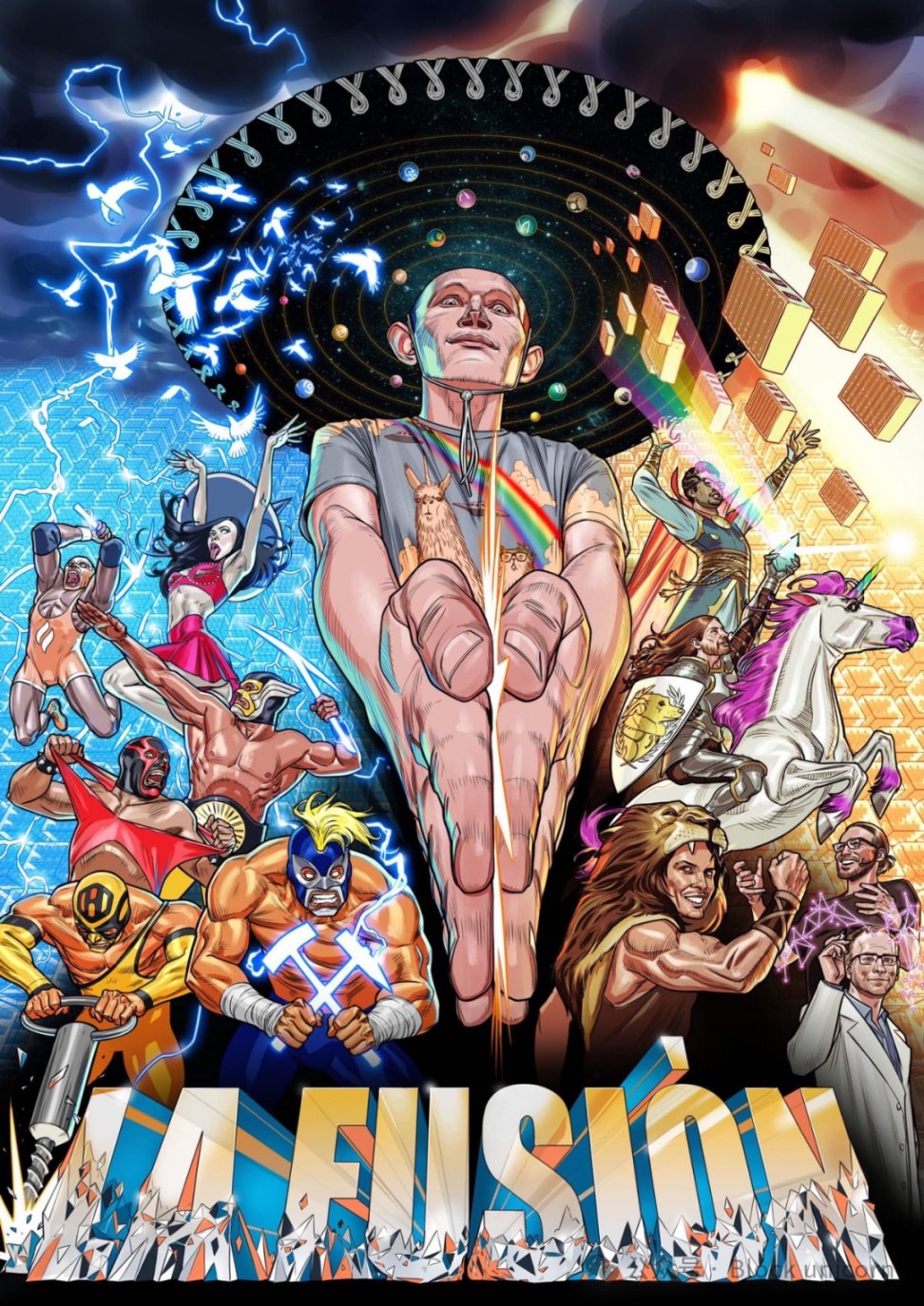Author: ryanberckmans
Compiled by: Block unicorn

Ethereum is the core blockchain for L2 and L1 applications in the new global financial system, and no other chain will be able to match it. Mert (CEO of heliuslab, OG of the Ethereum community) has suggested that Solana can transform into a core blockchain, but Solana will never become a core blockchain. Here are five reasons why.

Four years ago, Ethereum pivoted to focus on becoming the core blockchain for the new global financial system for both L2 and L1 applications. Ethereum’s core blockchain strategy is increasingly being seen as a top L1 strategy and a smart move - although it’s still early days, but if you look closely, there are signs that imitation is the sincerest form of flattery and L2 is taking over.
Solana has performed well this season in terms of decentralized finance (degen) and meme growth, as well as SOL price. However, I think Solana's leadership has begun to see the trend of L2 cannibalizing the market share of alternative L1. Now, they seem to be suggesting that Solana can also transform into a core blockchain like Ethereum.
But Solana is fundamentally unsuitable as a core blockchain for L2 or world-scale L1 activity. I’ll explain why in detail below.
First, let’s discuss how Solana’s leadership seems to be gradually acknowledging that Ethereum’s L2 core blockchain strategy is excellent and that Solana may be transitioning to pursue becoming a core blockchain.
Initially, Solana claimed that it would be so fast and cheap that the entire world would use a single Solana chain. This was their "monolithification" period, and that was the concept they pushed until it became a burden (because there is no single entity in the world that can serve the entire world), after which they shifted their marketing strategy to the concept of "integration."
Then, in the middle of this year, Solana admitted that L2 was the right path. Several reasons prompted the change, including: Solana leadership noticed that some of its flagship applications began to build custom L2 application chains on Solana - this was due to the common reasons why customers prefer L2 (i.e. control and customization, while being part of a whole and not having to run consensus themselves). Earlier this year, a well-known Solana community member wrote a passionate post calling for Solana to adopt L2 - the Solana community was outraged because they did not agree with this view before its leadership admitted the inevitability of L2. In addition, a major Solana development team switched to scaling to build SVM L2 on Ethereum (from Solana L1 applications to Ethereum L2). As a result, Solana leadership began to lean towards L2.
(It’s worth noting that rather than admitting that Ethereum was right all along about L2, Solana is claiming that their L2 is not L2 but is actually “network scaling”, which is a huge marketing gimmick. This is similar to Solana’s recent concept of “True tps”, which they had to invent because they have been inflating Solana’s tps (transaction processing capacity) for years on many information sites, including by factoring in 80% (!!) consensus overhead. Many sites still claim Solana’s tps is 3000, but it’s actually around 750tps. They invented “True tps” to counter the long-reported “False tps”. My point is that serious on-chain investors should look carefully at Solana’s claims when doing due diligence - many of them don’t stand up to scrutiny.)
Fast forward to this month, and now Solana’s leadership is starting to talk about how they can simply move to Ethereum’s backbone strategy (but they can’t pull it off, for reasons listed below).
So why is Solana leaning towards Ethereum’s core blockchain strategy now? Why now?
This is because everyone is finally starting to realize that the world needs many new chains (thousands), and L2 is generally much more cost-effective than replacing L1 (which is why Coinbase, Kraken, Sony, and EVE Online, etc. choose L2), so being the core blockchain of L2 is the top strategy.
So can Solana pivot to become a core blockchain? No, Solana cannot pull this off (here’s why).
In fact, Solana is in serious trouble in terms of technology and economic strategy. What specific difficulties does Solana face?
- Solana will not be fast enough or cheap enough to meet even a small fraction of the world’s coming demand.
- Solana is not decentralized enough to attract real “whale” capital.
- Solana cannot become a competitive global backbone chain for L2.
- Solana bundles consensus and execution together, which is more expensive and slower than just doing execution. This is why the most scalable L2 chains only need to do execution without dealing with consensus, and are able to benefit from the composability network effects of overall trustlessness, making them faster and cheaper than Solana very soon. See MegaETH.
This needs to be emphasized again because it is crucial: not only will Solana not become backbone, it will soon not even be the fastest or cheapest chain.
To some people (including many investors) right now, Solana may look like the best option in every way — a better version of Ethereum. But nothing could be further from the truth. Soon, Solana will be nothing, both technically and economically.
Five reasons why Solana will never become a global core blockchain
1) Solana lacks true client diversity and it will be difficult to achieve in the foreseeable future.
Client diversity means that the chain is run by multiple independent programs in parallel. This is very helpful for preventing both attacks (multiple independent development teams and programming languages) and accidents (multiple code bases, as bugs are often confined to a single code base).
User diversity is a necessary condition for the global core blockchain (now Solana only has MEME supporting the survival of the network).
a) To achieve client/user diversity, no single program can hold the majority of validators’ stake, which requires at least three independent chain clients and a balanced stake distribution between them. In addition, a detailed PDF protocol specification and an upstream research community are required. The protocol specification determines the "definition" of the chain, as well as the correctness and reliability of this definition. This ensures that all clients are working towards the same rigorous goal.
b) Currently, Solana has only one production client (Agave Rust). Solana is working hard on a second client (Firedancer), but development is difficult and delayed because there is no real protocol specification or research community, and the Agave Rust client is highly optimized and deeply dependent on the underlying hardware, which also increases the difficulty of extracting the protocol specification from the low-level design and re-implementing it in the new client.
c) Firedancer is still a long way from being able to run 50% stake in production as a standalone code base, and it may take years.
d) Even if Solana puts Firedancer into production in the future, they still won’t have client diversity. To do that, they need at least a third production client (so that no one client has more than 50% of the stake), a balanced stake distribution between them, and all three clients must be 100% original code bases with no code overlap, overlapping development teams, overlapping code dependencies/libraries, and in different programming languages.
Ethereum already has four production chain clients that meet these standards and has for several years.
2) The second reason why Solana will never become a global backbone is that its chain requires very high bandwidth (recommended upload speed is 10Gbps), which increases the risk of significant real-world centralization.
The core purpose of a global core blockchain is to minimize all forms of risk, so burdening it with extremely high bandwidth requirements is not feasible.
High bandwidth requirements are difficult to circumvent, and while you can buy a high-powered computer and take it anywhere, it's nearly impossible to get 10Gbps upload speeds in many areas, especially outside of a corporate data center or over a VPN connection.
The global backbone must be able to run anywhere. Being able to run the backbone anywhere at any time (even the possibility of bypassing the data center entirely in the future) is a critical part of reducing risk.
Today, Solana’s recommended upload speed is 10Gbps, and will increase further in the future, so bandwidth issues will only get more severe for Solana over time.
3) Solana is at high risk of future downtime: Solana has experienced stagnation many times in the past and lacks Ethereum’s protocol-level fallback mechanism, allowing it to continue generating blocks even if it cannot be “finally confirmed.”
When the global core blockchain carries 200 countries and $100 trillion in assets, it is particularly important to maintain stable operations, including never going offline.
4) Solana lacks economic decentralization: Only about 2% of its initial token offering (TGE/ICO) was sold publicly, and about 98% was allocated to insiders.
Ethereum achieved widespread distribution through a seven-year PoW high inflation mechanism after the initial 80% public sale, as miners had to sell almost all ETH to pay for mining costs.
Economically and operationally, Solana is highly centralized, increasing systemic risk and reducing its suitability as a global core blockchain.
5) L2’s zk proof aggregation enables the L1 global backbone to not sacrifice decentralization for scalability under any circumstances.
Although Eth L1 (Layer 1 network) is not focused on execution expansion, in the future the world's L2/L3 (Layer 2 and 3 networks), and even thousands of chains, will be able to complete settlement on Ethereum through zk aggregation.
Solana focuses on L1 execution expansion, but for the global core blockchain, this is a burden on the needs of decentralization and public neutrality.
Summarize
Therefore, Solana will never be able to become the core blockchain of the new global financial system.
In my opinion, Solana will not even become “a” core blockchain, as its market share will decline year by year, and it will be at a disadvantage compared to Ethereum (L1+L2) in key metrics such as non-native application funding or major enterprise integration. The reason is that the world has a better chance of choosing Ethereum L2 or L1 on the chain than using Solana or other chains. Don’t take my word for it, just look at the choices of existing and upcoming enterprises and governments such as Coinbase, Kraken, Sony, Visa, the City of Buenos Aires, and many others.
Any company or government that seriously considers blockchain will find the above key factors, which will be factors that companies and governments around the world need to consider deeply when investing or building in the future.
Ethereum will become the core blockchain of the new global financial system. No other chain can compare with it, including Solana. L2 is eroding the market share of L1 alternatives and promoting ETH to become a circulating currency, which will bring huge value accumulation to ETH.












